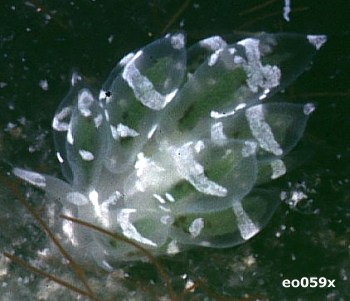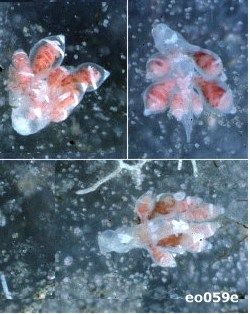Egg-eating aeolids
July 22, 2000
From: C.Carlson & P.J.Hoff

Bill,
Here are some scans of one of the 4 or 5 'internal' egg eaters that we have. We have yet to find any on 'worm' egg masses though it is common to find both worm and cephalaspid, generally haminoeid, masses side by side on the sand. They can look almost identical. We think we can tell them apart by the nature of the attachment. The worm masses have a hole where they attach to the sand -- the haminoeids, none.
eo059x: 4.5mm; Guam, Toguon Bay, 8m; 14 May 1983. [food source unknown].
eo059e: in egg mass of Atys multistriata Schepman, 1913.
Length: 2.5 - 4mm. Guam, Toguon Bay, 8m; 14 May 1983.
We do have some observations of an eolid feeding on a non-opisthobranch egg mass though the situation was not natural. A number of years ago we went through 5 or 6 generations of another egg eater in our aquarium. We would find the juveniles and adults feeding on the eggs of Bittium
zebrum. The cerithids had been introduced earlier on a rock used as a
background for photography.
Clay & Patty Jo
clay.carlson@kuentos.guam.net


Dear Clay & Patty Jo,
Thanks for the information. I have put the photos of the second species you sent onto a separate page. It looks like the egg-eating species species Denise has just reported from Sulawesi may be feeding on haminoeid eggs rather than my suggested worm eggs. I thought I could identify the difference, which only goes to show it doesn't pay to be too confident.
The green and red ceratal digestive gland is interesting. I would have assumed that they would get the pigment from the eggs they feed on, but this is apparently not the case here. I guess it is possible they have been feeding elsewhere before they found this egg mass, but at this small size it seems unlikely. I will tentatively identify them as species of Favorinus.
Best wishes,
Bill
Related messages
-
Photos of another egg-eating aeolid
From: Terry Gosliner, August 11, 2000
